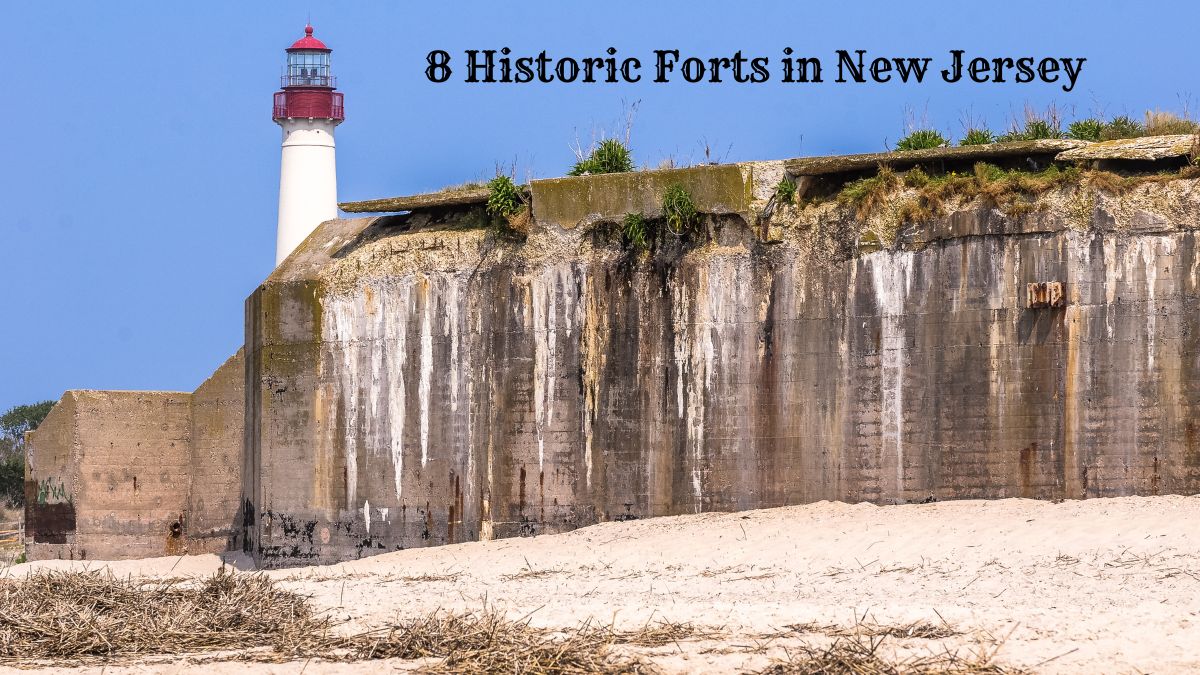Located between the bustling metropolis of New York City and the tranquil waters of the Delaware River, the Garden State’s landscape is dotted with remnants of a rich military history.
In this article, Historic Forts in New Jersey, we delve into these fortified sentinels that have stood the test of time, bearing witness to numerous historical events, from revolutionary battles to pivotal moments in World War II.
Join us as we embark on a journey through New Jersey, exploring these silent guardians and uncovering the stories they hold within their walls.
8 Historic Forts in New Jersey
| 1. Fort Hancock | 6. Fort Billingsport |
| 2. Fort Mott | 7. Fort Mercer |
| 3. Fort Lee | 8. Fort Nonsense |
| 4. Fort Dix | |
| 5. Fort Monmouth |
1. Fort Hancock
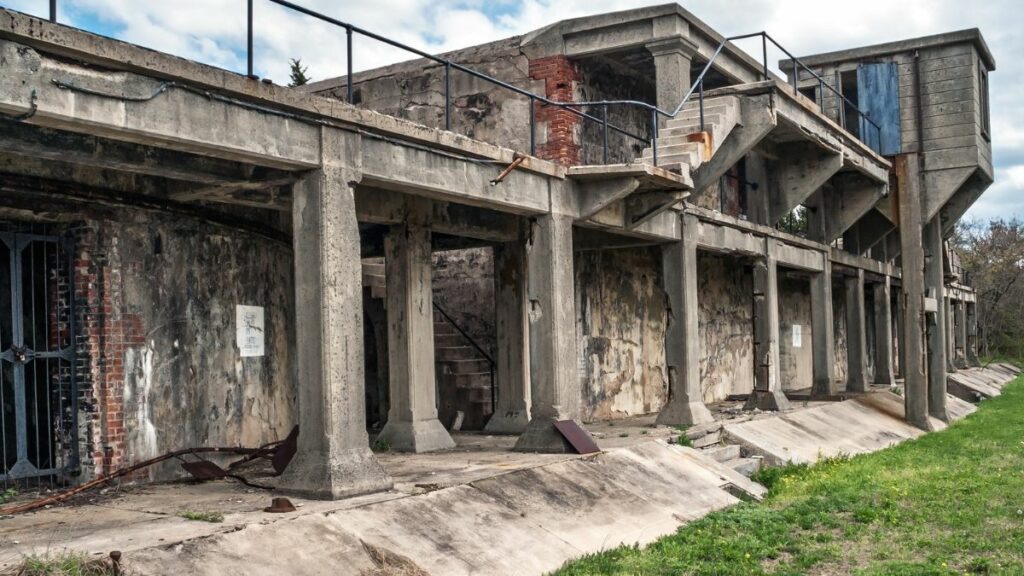
Located strategically on the Sandy Hook Peninsula in New Jersey, Fort Hancock is a testament to the United States’ commitment to coastal defense.
With its panoramic views of the New York Harbor, this fortress played a pivotal role in guarding one of the nation’s most critical maritime gateways. Established in the late 19th century, its purpose was clear: to defend the harbor and its encompassing metropolitan areas from potential naval threats.
A Fort Equipped for Modern Warfare
Fort Hancock wasn’t just any ordinary military installation. As naval warfare evolved with the advent of more sophisticated ships and armament, so did the fort.
It was home to numerous large-caliber guns and weapon systems designed to deter and combat modern seafaring enemies throughout its active years. The fort’s extensive range of batteries, some of which housed guns with barrels extending several dozen feet, were explicitly positioned to repel hostile ships from entering the harbor.
The World Wars and Beyond
With the onset of the World Wars, Fort Hancock’s significance grew exponentially. Serving as a first line of defense for New York City and the broader northeastern coast, its troops and artillery systems stood ready to counter any naval offensives.
Post-World War II, as threats changed and technology advanced, Fort Hancock transitioned to accommodate new defense systems, including anti-aircraft missiles.
Decommissioning and Today
Fort Hancock was decommissioned by the 1970s with shifts in military strategies and the advent of more advanced defense systems. However, its legacy as a coast guardian was far from forgotten.
Today, much of the area surrounding Fort Hancock is part of the Gateway National Recreation Area, managed by the National Park Service. Visitors can explore numerous historic structures, including the batteries, barracks, and administrative buildings, offering a tangible link to the past.
Legacy and Reflection
Fort Hancock’s imposing silhouette against the backdrop of the Atlantic is a powerful reminder of the lengths to which nations go to defend their shores. As one wanders its historic grounds, there’s a palpable sense of the weight of responsibility carried by the soldiers stationed there throughout its operational years.
Fort Hancock is a shining beacon in the broader tapestry of American military history, symbolizing the nation’s commitment to safeguarding its people and shores.
2. Fort Mott
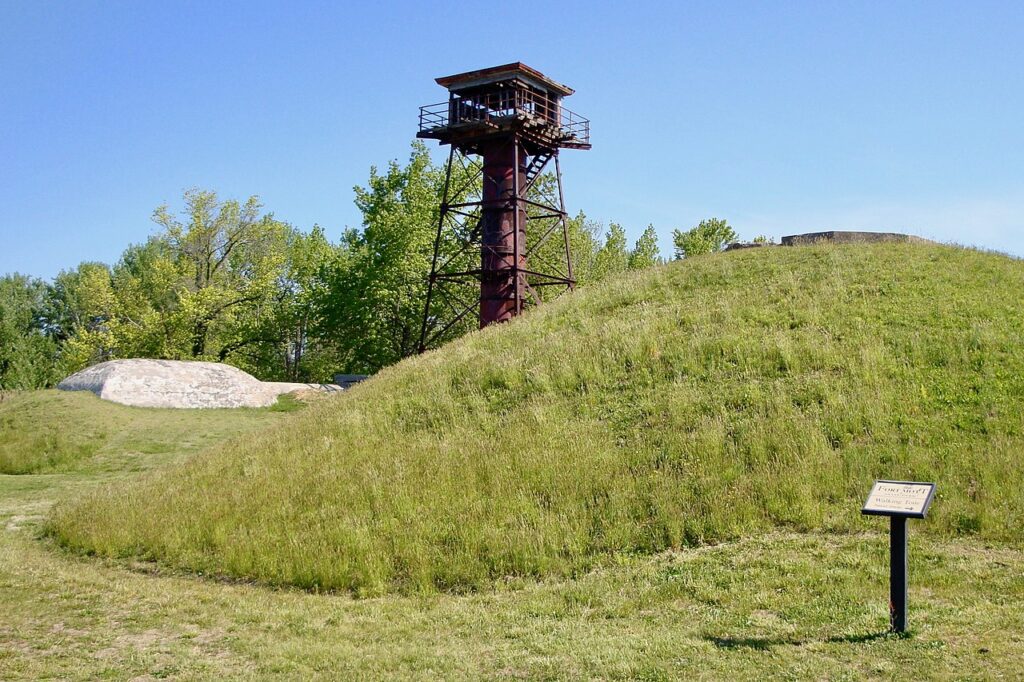
Perched on the banks of the Delaware River in southern New Jersey, Fort Mott was strategically positioned to guard one of the critical waterways connecting the rich industrial regions of the American Northeast to the Atlantic Ocean.
Commissioned towards the end of the 19th century, Fort Mott, along with other installations on the Delaware, was tasked with defending the river against potential naval invasions, ensuring the safety of American commerce, industries, and nearby urban centers.
From Civil War Anticipation to Concrete Reality
The origins of Fort Mott can be traced back to the Civil War era when there was a perceived need for a defense system along the Delaware River.
Although initial plans and land purchases were made during this period, it wasn’t until the late 1800s that substantial construction began. This push was part of a nationwide initiative to fortify the coastlines, especially after the vulnerabilities observed during the Civil War.
Armament and Defensive Prowess
Fort Mott was designed to be a fortress equipped for modern warfare. It boasted multiple gun batteries, some equipped with disappearing guns – a technological marvel of the time – which would retract behind protective barriers after being fired. These fortifications substantially deter any hostile force considering a naval approach via the Delaware River.
Transition and Decommissioning
Despite its impressive arsenal, Fort Mott never fired a shot in anger. With the advent of the 20th century and the changing dynamics of global warfare, the strategic importance of such coastal defenses began to wane.
By the time World War II ended, advancements in aviation and long-range missiles rendered many such forts obsolete. Consequently, Fort Mott was decommissioned in the mid-20th century.
Today’s Fort Mott State Park
The fort’s grounds have been transformed into Fort Mott State Park, offering visitors a blend of natural beauty and historical exploration.
The preserved ramparts, gun batteries, and other structures provide a window into past military strategies and technologies. Coupled with its scenic views of the Delaware River, the park is a popular destination for history enthusiasts, families, and nature lovers.
3. Fort Lee

Fort Lee offers a commanding view of the Hudson River and its vast expanse atop the Palisades in New Jersey.
Established during the early days of the American Revolutionary War, this fortification was paramount in the Continental Army’s efforts to control access to the Hudson and prevent British naval advancements.
Genesis: The Hudson River Defense
The Hudson River was vital in the Revolutionary War’s chess game. The British understood that controlling the river would effectively split the rebellious colonies in two, hindering communication and troop movement.
Fort Lee was established in 1776 to counter this, complementing its sister fort, Fort Washington, located directly across the river in New York. Together, these two forts were tasked with deterring and challenging the British Royal Navy’s efforts.
Fall and Evacuation
Despite its strategic positioning and the heroism of its defenders, Fort Lee faced significant challenges. British and Hessian forces captured Fort Washington a few months after its establishment.
Recognizing the imminent threat, General George Washington ordered the evacuation of Fort Lee. The subsequent retreat marked a crucial moment in the war, leading to Washington’s famous crossing of the Delaware River and the much-needed victory at Trenton.
Legacy of the Fort and the Borough
After the war, its legacy lived on while the fort fell into ruin. The surrounding area would eventually take its name, and the Borough of Fort Lee was officially incorporated in the early 20th century.
The fort’s historical significance is further immortalized by naming the George Washington Bridge’s western terminus, providing a continuous link between Fort Lee and Manhattan.
Today’s Fort Lee Historic Park
Now a part of the Palisades Interstate Park system, Fort Lee Historic Park encompasses the fort’s original grounds. With reconstructed military encampments, authentic cannons, and interpretive programs, it allows visitors to step back in time.
The park’s breathtaking views of the George Washington Bridge and New York City skyline are a poignant reminder of the region’s military and cultural heritage.
A Reflective Gaze Across the Hudson
Fort Lee’s silent battlements, looking out over the shimmering waters of the Hudson River, stand as a testament to the sacrifices and strategic maneuvers of the Revolutionary War.
While the cannons no longer roar and soldiers march on its grounds, the spirit of resistance, resilience, and revolutionary fervor remain palpable. For those who visit, Fort Lee is not just a historical site; it’s a journey into the heart of America’s quest for independence.
4. Fort Dix
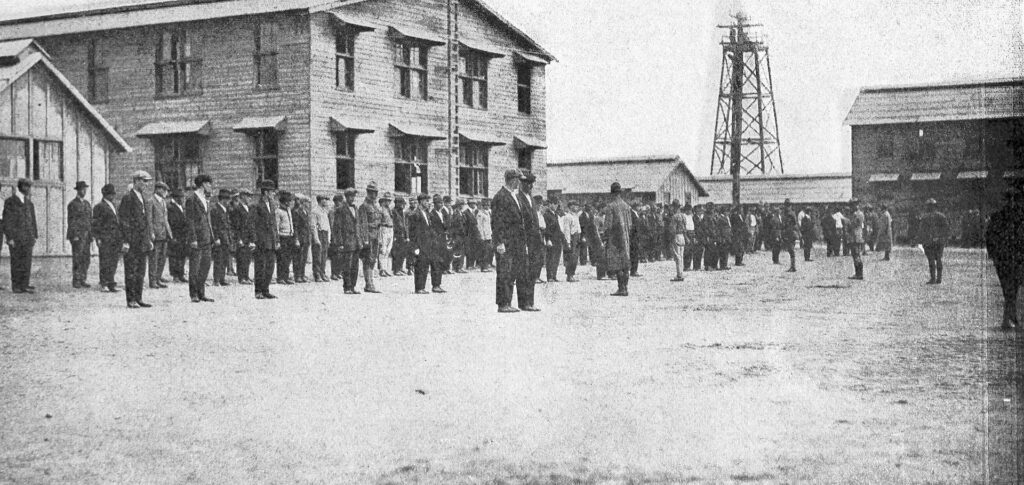
Fort Dix’s roots extend back to 1917 when the United States was preparing to enter the tumultuous fray of World War I. Recognizing the need for extensive training grounds for soldiers, the U.S. Army established Camp Dix, named in honor of Major General John Adams Dix, a veteran of both the War of 1812 and the Civil War.
Positioned within New Jersey’s vast Pine Barrens, this camp would soon evolve into one of the nation’s most crucial military installations.
Transitioning to Fort Dix and World War II Significance
The facility underwent significant expansion From its inception as a temporary cantonment for training troops during WWI.
It was redesignated as a “fort” in 1939. As World War II raged, Fort Dix became a hive of activity, serving as a training ground for soldiers, a staging area for troops departing overseas, and a demobilization center for those returning from the European and Pacific theaters.
Cold War to Modern Era
Throughout the Cold War, Fort Dix played a pivotal role as a primary training facility and later as a center for Reserve and National Guard activities. Its importance was further underlined during the Vietnam War and subsequent military operations, where it acted as a training and deployment hub.
In 2009, reflecting the evolving nature of the U.S. military and the need for greater interbranch cooperation, Fort Dix was consolidated with the adjacent McGuire Air Force Base and Lakehurst Naval Air Engineering Station, forming the Joint Base McGuire-Dix-Lakehurst. This transition made it one of the Department of Defense’s only tri-service joint bases.
Humanitarian Efforts and Notable Events
Fort Dix’s significance isn’t solely tied to its military operations. The base has served as a refuge during various humanitarian crises. Notably, in the 1990s, it acted as a temporary haven for Kosovar Albanians fleeing conflict and later for Hurricane Katrina evacuees in 2005.
Visiting Fort Dix Today
While portions of the Joint Base remain operational and restricted, there are areas accessible to the public, offering insights into the fort’s rich history. Various commemorations, ceremonies, and events held on the base ensure that the legacy of Fort Dix and its contributions remain in the public consciousness.
A Century of Service and Beyond
From WWI origins to its current status as a joint military base, Fort Dix is a testament to America’s enduring commitment to defense and readiness.
Its history encapsulates the evolution of military strategy, the bravery of countless soldiers who passed through its gates, and the adaptability of the U.S. Armed Forces. As the base moves forward into the 21st century, it embodies the spirit of service, innovation, and unity.
5. Fort Monmouth
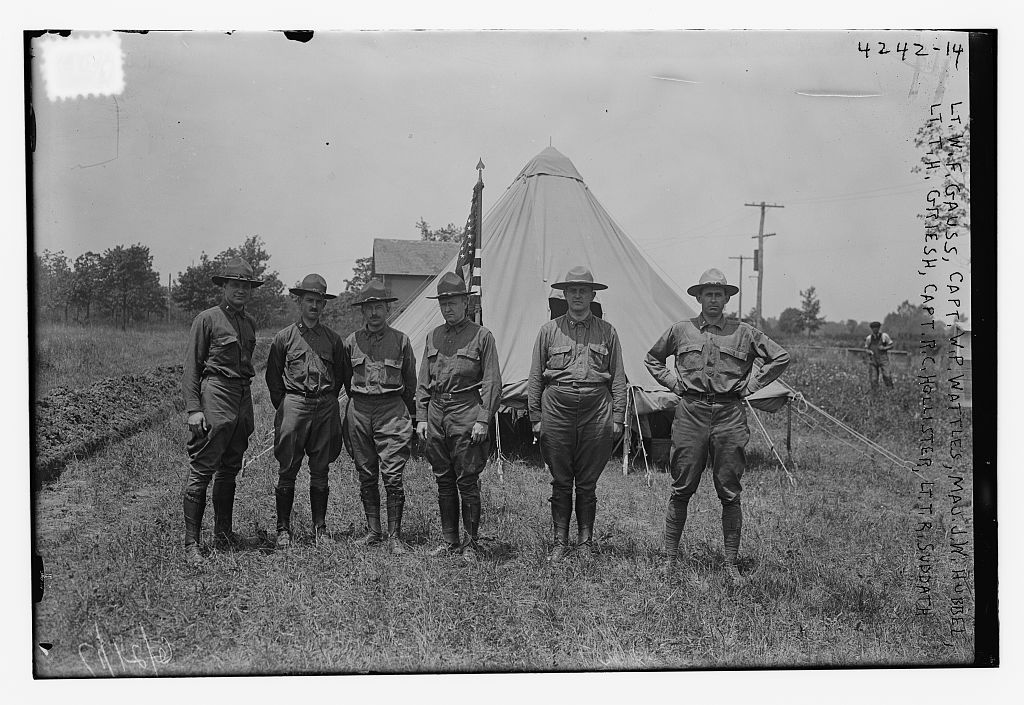
Fort Monmouth, initially named Camp Little Silver, began in 1917 during the buildup to America’s involvement in World War I.
Recognizing the critical role of communications and technology in modern warfare, the U.S. Army Signal Corps established this facility as a signal training, research, and development point. Located in Monmouth County, New Jersey, it was soon renamed Fort Monmouth in 1925 in honor of the American Revolution’s Battle of Monmouth.
The Evolution of Communications and Radar Development
The 1930s and 1940s were transformative decades for Fort Monmouth, as it became the epicenter of the Army’s research into radar technology.
This commitment bore fruit during World War II when radar systems developed at the fort played a pivotal role in European and Pacific theaters. Fort Monmouth’s researchers and engineers were instrumental in creating the technological advancements that changed the dynamics of modern warfare.
Cold War Innovations
Fort Monmouth continued solidifying its reputation throughout the Cold War as the Army’s premier center for electronic research and communications development.
As tensions rose and technology evolved, the fort facilitated advancements in satellite communications, surveillance, and electronic countermeasures, directly contributing to the United States’ strategic edge during this protracted geopolitical standoff.
Post-Cold War and 21st Century
In the post-Cold War era, Fort Monmouth remained at the forefront of technological advancements, especially in the fields of information technology, communications, and electronic warfare.
The challenges of the 21st century, from counter-terrorism operations to cyber warfare, saw Fort Monmouth adapting and innovating to meet the demands of an ever-changing battlefield.
Closure and Legacy
Despite its numerous contributions, Fort Monmouth was not immune to the realities of military restructuring. In 2005, the Base Realignment and Closure (BRAC) Commission recommended its closure, with its missions transitioning to the Aberdeen Proving Ground in Maryland. By 2011, Fort Monmouth had officially ceased its operations.
Today, the grounds are undergoing redevelopment, with parts of the fort being repurposed for civilian use, including technology businesses, housing, and recreational spaces. The Fort Monmouth Economic Revitalization Authority oversees this transformation, aiming to create a sustainable community while honoring the site’s storied past.
6. Fort Billingsport

Fort Billingsport, located in Paulsboro, Gloucester County, New Jersey, is one of the earliest forts purchased by the Continental Congress during the American Revolutionary War.
Recognizing the strategic importance of the Delaware River as a primary route for supplies and communication, Congress moved swiftly in 1776 to establish a defense system to prevent British naval forces from accessing Philadelphia.
Strategic Importance
The fort’s prime location on the Delaware River made it a key piece in the tri-fort defense system, including Fort Mifflin and Fort Mercer. These fortifications formed a barrier to obstruct and challenge the British Navy’s movements.
Challenges and British Assaults
Though Fort Billingsport was instrumental in the early defensive strategies, it faced significant challenges. The British recognized the tri-fort system as a formidable blockade and repeatedly strategized ways to bypass or overcome it.
During the war, the fort faced potential threats from British naval forces and constantly needed reinforcement and repairs.
Legacy and Current Status
While the original fortifications no longer stand today, the area once occupied by Fort Billingsport is a testament to the resourcefulness and determination of the American forces during the Revolutionary War.
The fort’s legacy is maintained by historical markers and is commemorated by the local community, who recognize its pivotal role in the defense of the nascent United States.
Visiting Fort Billingsport Today
Today, visitors to the Paulsboro area can find traces of Fort Billingsport’s past in local museums, historical tours, and commemorative events. The site serves as a poignant reminder of the sacrifices and strategic decisions made during one of the most tumultuous periods in American history.
7. Fort Mercer

Located on the Delaware River’s eastern shore in what is now National Park, Gloucester County, New Jersey, Fort Mercer was a crucial fortification during the American Revolutionary War.
With its counterpart, Fort Mifflin, located across the river in Pennsylvania, the two forts worked in tandem to protect the approach to Philadelphia and prevent the British from using the Delaware River for their naval operations.
A Partnership of Defense
The primary mission of Fort Mercer and Fort Mifflin was to guard the chevaux-de-frise, a series of underwater obstacles and spikes intended to deter British naval advances up the river.
This defense was instrumental in the 1777 Philadelphia campaign, where the British sought to capture the revolutionary capital.
The Bold Stand of 1777
Fort Mercer’s most notable confrontation came on October 22, 1777, when Hessian forces under Colonel Carl von Donop launched an attack.
Despite being significantly outnumbered, the American defenders, under the command of Colonel Christopher Greene, repelled the assault, inflicting heavy losses upon the Hessians, including the wounding and capture of von Donop himself.
Decline and Abandonment
Despite the valiant defense, the situation for Fort Mercer grew grim when Fort Mifflin fell in November 1777.
With its twin fort defeated and British ships now able to approach more closely, Fort Mercer’s strategic value diminished. Recognizing the vulnerability, American forces abandoned the fort shortly after Fort Mifflin’s fall.
Legacy and Preservation Today
Today, the area once housed Fort Mercer is known as the Red Bank Battlefield. The site has been transformed into a historical park where visitors can learn about the fort’s history, explore the remnants of its earthworks, and participate in events that commemorate its role in the Revolutionary War.
8. Fort Nonsense
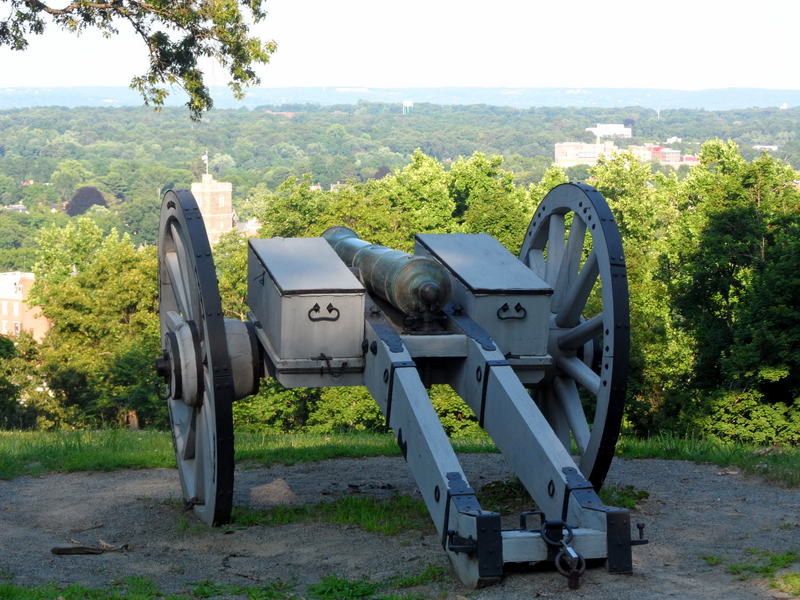
Once located atop a hill in Morristown, New Jersey, Fort Nonsense symbolizes the strategic military maneuvers during the American Revolutionary War. Its elevated position provided a clear vantage point over the town and surrounding areas, ensuring the Continental Army had a strong line of sight to detect any advancing British forces.
Washington’s Command
General George Washington ordered the construction of this fortification in 1777. It was intended to serve as a defensive structure for the Continental Army during their winter encampment in Morristown. With its fortifications, the army could rally and defend against any potential threat from the British.
The Mystery Behind the Name
“Fort Nonsense” carries a certain amount of enigma. One popular theory suggests that, given the fort’s lack of military action and rapid construction during relative peace, residents coined the term, believing the fort served no real strategic purpose.
Another notion is that soldiers, questioning the rationale behind building a fortification when the British were not in the immediate vicinity, dubbed it “nonsense.”
Legacy in Modern Times
While the fortifications have not survived intact into the present day, the site remains preserved as a historical landmark. It’s now part of Morristown National Historical Park, encompassing several pivotal locations from the Revolutionary War era.
Visitors can explore the site, walk the grounds, and contemplate Washington and his officers’ decisions during a critical period in American history.
Related: 10 Historic Forts in New Mexico
How Fort’s Played Role in the American Revolution
During the American Revolution, the strategic location of New Jersey provided the setting for numerous key battles and military encampments.
Historic forts, like Fort Constitution, played a crucial role in the Continental Army’s defense against British forces. Commanded by General George Washington, the Continental Army relied on these fortified positions to stand their ground and advance toward victory.
Fort Constitution served as a defensive stronghold and a base for the Revolutionary forces. American forces operated it throughout the war in Morris County. This fort was also on private property, demonstrating local citizens’ commitment to supporting the war effort.
As the war raged on, the American Revolution witnessed the remarkable contributions of vital military figures like General Washington and his aide-de-camp, Alexander Hamilton.
Their leadership and strategic planning allowed the Continental Army to defend these essential forts successfully. Displaying their knowledge of military tactics, Washington and Hamilton were instrumental in repelling British forces and winning decisive battles.
Modern Day Relevance
Historical Sites and Museums in New Jersey
New Jersey has many important historic sites and museums, allowing residents and visitors to learn about and explore the state’s rich history.
One such site is the Old Barracks Museum on Main Street in Trenton. This National Historic Landmark served as a British barracks during the Revolutionary War and later as housing for American soldiers. Today, the museum offers guided tours, special events, and a visitor center for those interested in learning more about the state’s colonial past.
Morristown National Historical Park, another significant site, preserves several key locations from the Revolutionary War period. It includes a picnic area, a welcome center, and some trails for visitors to enjoy. The federal government manages the park, and is often used for special events celebrating the region’s history.
Near New Jersey, New York City also influences the state’s historic relevance. Many visitors take day trips from the city to explore New Jersey’s historic sites and experience its unique history.
Preservation Efforts
The State of New Jersey and the federal government are committed to preserving historic landmarks and ensuring they remain accessible to the public. This is evident in the ongoing financial support and management of sites like Morristown National Historic Park.
Preservation efforts are also supported by private organizations and local communities, who work together to maintain the integrity of historic sites and resources. These efforts contribute to the tourism industry by attracting visitors worldwide and providing educational opportunities for students and history enthusiasts.
Related: Historic Forts in North Dakota
Conclusion – Historic Forts in New Jersey
With its forts and military installations, New Jersey offers a rich tapestry of American history waiting to be explored.
Whether you’re a history buff or just curious, the state promises a journey through time, tracing the footsteps of those who’ve shaped the nation.
If you have visited any of these forts, we would love to hear about your experience in the comments section below.

Cory is a website owner and content creator who enjoys fishing, history, coin collecting, and sports, among other hobbies. He is a husband and father of four.
Romans 15:4 For whatever was written in former days was written for our instruction, that through endurance and through the encouragement of the Scriptures we might have hope.

